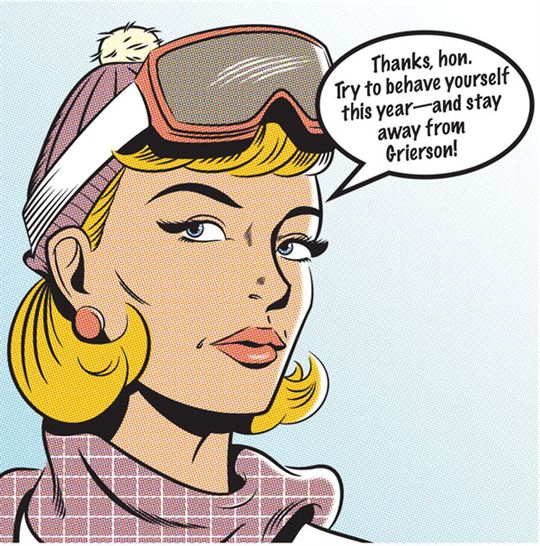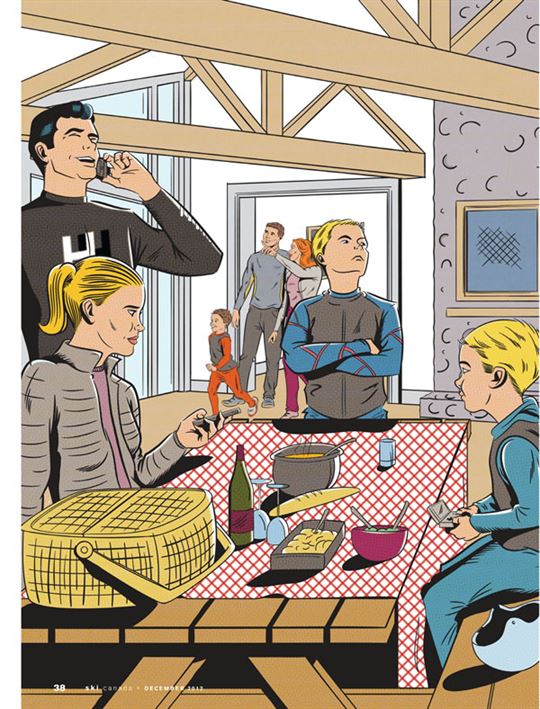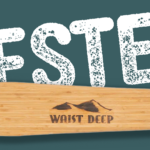by Lori Knowles in December 2012 issue
Ski Canada reporter Lori Knowles goes undercover to get the scoop on Ontario’s private ski clubs.
It’s the kind of winter idyll caught best in a painting, or in one of those vintage ski photographs: black and white, or perhaps strong-coloured Kodachrome, a snow-laden chalet, a whirlwind of woollen sweaters and tall tuques and old Carrera goggles, a lot of smiles, no one looking directly at the camera…
Private ski clubs, particularly those along “the escarpment” near Collingwood, Ontario, have always maintained an aura about them. Privileged. Happy. Enigmatic. Envied. Even resented. Many Ontario skiers drive by one or two on their way to Blue Mountain, the only public ski area in Collingwood—and pass the gates of private ski clubs. The sign is easy to read: “Members Only.”
What goes on behind those gates? What are “the members” like? And the biggie: How much does it all cost?
The Mornings
A Saturday morning at one of the Escarpment Four—Osler Bluff, Craigleith, Alpine or Georgian Peaks—is anything but idyllic. Frenetic is a better word. Organized yet chaotic. Costly wheels—Mercedes, Acura, Porsche, BMW, big honkin’ SUVs driven by Lulu outfits. There are also some Honda minivans, a few trucks and the odd university student’s Mazda beater. Shuttle buses come and go—little yellow ones carrying skiers, not from the city or the nearby town, but from the members’ private chalets on “the property.” At some clubs, parking attendants are waiting to line up the Escalades properly. Sometimes these attendants are acknowledged politely. Sometimes they’re ignored.
Every single morning, the competition starts here in the parking lot—the winners score the closest parking spots. Closer is always better. Once parked, Mum, Dad and the kids throw open the doors and hatchback and out comes the gear: ski boots, helmets, enormous lunch spreads. Skis are already stored in the club’s locker room. At more than one club, there are greeters on duty to give members a hand.
The families trudge in. They struggle with locker combinations, rush to get their skis outside to cool, squeeze themselves into racing skins and buckle boots. At the Escarpment Four, there’s an omnipresent, indeed, dominating emphasis on ski racing among kids—but also among those kids’ parents who compete down in the city rat race during the work week when most of the clubs bullwheels sit silent.
Children are herded frantically outdoors to meet their coaches by 8:30. The “adult racers” in the house and interclub leagues rush to inspect their slalom courses. At first glance some might even describe the scene as pretty: candy-coloured jackets, pants and helmets glow against an all-white backdrop. But as the bullwheels start spinning, champing-at-the-bit racers fall into neat lineups, last-minute “Meet me in the chalet for lunch!” orders are given—and they’re off!
The rest—those who don’t race or even ski—head indoors for a chat and a second coffee. Some head back to the “farm” to discuss polished granite countertop choices with their kitchen designer.
The Clubs
Private ski clubs pretty much remain a phenomenon exclusive to Southern Ontario: Caledon, Devil’s Glen, Toronto Ski Club, the Escarpment Four, Beaver Valley, Heights of Horseshoe—plus, the biggest of the lot, lonely HoliMont almost an hour south of the border in Ellicottville, N.Y. (Not surprisingly, half of HoliMont’s membership is from Southern Ontario.) Mention “private ski clubs” on a lift anywhere else in the country, or world for that matter, and you’ll probably get a quizzical look: “Your ski resort is private?” Although commonplace in the worlds of golfing and sailing, the “members only” concept for skiers is often unfathomable to Albertans and B.C. skiers, or those used to skiing in the land of plenty.
Historically, the ski club’s genesis came not so much from a want to exclude others, but as a way into a community of dedicated skiers. Back in the 1940s, founding members weren’t necessarily wealthy and well established. (Okay, a lot were.) But many were simply dedicated to skiing in an age when the sport wasn’t developed; they worked as a group to cut trails out of forests, build basic lodges, jury-rig simple tows—and set racecourses. They hired local farmers to help, but the members themselves worked hard on their non-profit organizations. They were a hearty bunch, flogging their private club “shares” to anyone who could raise $100.
“In those days, when you walked into the clubhouse at Osler Bluff, you walked up big stone steps,” remembers one long-time member. “We’d be lacing up our leather ski boots. A local farmer would be in there cooking up a greasy breakfast of eggs and hash browns. We’d all hop on the toboggan on Sleighride, seated 12 aside, and get hauled up the hill. Sometimes the brakes would give and we’d all bail out. Someone’s dad would fix it. It was much more ‘hands on’ than it is today.”
Somehow the Escarpment Four emerged as the leaders. Each established its niche. Craigleith has always had a rep as being young, aggressive, fun, dynamic. Alpine is smaller and intimate—and in more divisive times, a club that would accept Jewish members. The one-time public ski area, Georgian Peaks, is big and brash, with steep, broad runs and a bar scene to match. Then to the south, sitting apart on its shared ancient shoreline that is the Niagara Escarpment, is Osler Bluff. Runs are smooth, lifts are fast, money is old. Today’s near-$60,000 initiation fee is the dearest. Always has been; always will be.
The Members
There are at least three subspecies of people who belong to private ski clubs: The Old, The New and The Second Gens.
The Old: The founding members are a dwindling lot. They’re nearing the ages of 80 and 90. Some still ski; most enjoy reverent welcomes when they enter the clubhouses. Many of these folks are what author Stieg Larsson (The Girl with the Dragon Tattoo) kept calling “captains of industry:” ex-bank presidents, surgeons, retired lawyers, heads of brokerages. But not all. Many joined in the early days with not much more than two nickels to rub together; they just loved to ski.
“Our club has a wonderful mix of people now,” says one long-time private club member, “because when many of them joined in 19-whatever—40 years ago—it was about the skiing. It was about family. You didn’t have to be a super-rich person to join, you just did it for love of the sport. And even today it’s still a club focused on a family activity. For many, it’s not about the flash. Besides, not all rich people are that way, you know. They’re not all snooty. Many are there because they enjoy skiing with their kids, their cousins, their grandkids…”
The New: You could have joined your private club as far back as the 1980s, but to founding members, you’re still a new member! New members didn’t get grandfathered into the club via some discounted junior membership program. New members have to have coin to join the club.
So what defines a newbie? Here’s the thing: there’s a very finite geography in Ontario for skiing. Skiing is expensive. Ski resorts are expensive. Infrastructure—high-speed lifts, snowmaking—is expensive. So initiation fees and annual dues (season passes) have gradually escalated at private clubs to the point where a private membership’s initiation fee will run you anywhere from $11,000 to $60,000. Annual dues can ding you for $2,500-$7,000 per family per season. Add in frequent assessments for infrastructure improvements—high-speed lifts and snowmaking are prime—plus costs for family chalets, condos, equipment, programs… Many members count on dropping $15,000-$20,000 for a family of four. Per year. On skiing. In Ontario. And remember, almost all private ski clubs are not equity—if you want to bail or retire, you can’t sell your membership. As one member puts it: “You join up, you put your money down and if you don’t like it, you’re toast!”
The point, simply, is this: Those with means now join private clubs. (The fact that most club members can’t rationalize or also afford a trip west or to the Alps each winter seems to be lost.)

The Not So New: And finally, there are The Second Gens ranging from 20- to 50-something. These souls are the offspring of The Old members. Some have money, some are struggling, many are simply in-between. Most love, love, love their private clubs. They party there. Their best friends are there. Some get married there. When they talk about their clubs they get all warm and fuzzy.
“It was like an oasis,” one member says about his childhood at an escarpment club. “We’d get there Friday night and would immediately start building snow forts. We’d toboggan the hills with no light. During the day, there was no thought of safety. Our parents would let us go off and ski, just let us go.”
“Even today I can do that with my kids,” says a Second Gen member. “They go skiing with their friends and meet us back for lunch. I don’t worry about them. I know if they get out of line, some other parent is going to recognize them, call them on it, then let me know. In fact, safety is a huge reason why we ski there as a family.”
“You know what I love about Georgian Peaks?” asks a Peaks member. “Everybody gets to know your kids. God forbid if your child gets hurt and you’re not nearby. There’s plenty of other parents there immediately to take care of them.”
The Rookies: Whoops. Wait…there’s at least one more ingredient in this stereotypical mix: the trial members. These folks are dipping their ski boots into the private club pool to see if it’s warm enough, without forking over the $15-, $25-, $35- or $55-grand it takes to plunge right in. Their trial memberships are good for about two years before they’re required to take the serious financial dive. Gone are the days of potential members wallowing for years on fat waiting lists.
When asked how they chose which club to sample, one recent trial member said: “At the one we chose, après skis are fun. There’s a nice lodge. It’s friendly. There’s a good gathering. The lift lines aren’t long—I suppose we’re paying for access to the short lift lines. It’s a way of battling the crowds. And the community here is welcoming. We know a lot of people.” The benefits of having their children grow up with other like-minded Upper Canadians isn’t discussed, but certainly exists. Another long-time private club member sums it up poignantly: “When you join a private club, you join your own social circle.”
The Clashes
This whole soupy private club mix leads to an interesting dynamic. Indeed, there are times when all these people clash. “Oh yeah, there’s a hierarchy,” admits a woman who’s been a member at two separate private clubs. “There are the original members, there are the new members, then there are the people like me who’ve ‘married in.’ There’s definitely a pecking order, whether it’s admitted or not.”
Old Members vs. New Members vs. Second Gens especially comes into play when you’re talking infrastructure upgrades and the enormous costs that go with them. “It’s hard to keep them all happy,” says a member who’s had Board of Directors experience. “Like at any club, some members aren’t keen on change, others want the best of everything: snowmaking, lifts, spacious clubhouses. It’s a struggle to find middle ground, but really it comes down to this: you have to keep up with the times. You have to keep up your facilities. And the cost is not getting more affordable. Everything’s going up in price. Skiing now is even more of a luxury.”
The Picnic Baskets
There are no waiters at private ski clubs, though waiters have been “suggested”—and you can guess which subspecies of members gets blamed for the idea. Private cafeteria food is sometimes good, sometimes great. But at private clubs, there’s always been a dominant and dedicated contingent of brown baggers. Picnic baskets are packed with great care: from baguettes and artisanal cheeses, to soups, something for the row of barbecues on the deck to tablecloths, candles… At some clubs, rows of Crock Pots quietly warm lunches all morning while everyone’s out on the hills. Some tote panini grills, fondue pots or raclette warmers—though we’re told rulemakers at at least one of the Escarpment Four have prohibited these foodie toys, along with the wine and beer that typically is pulled from baskets, flaunting provincial authorities.
“I love it,” says one devoted brown bagger. “It’s an activity we can do as a family. We sit down together, see our friends, eat with our kids. We’re shoulder to shoulder with older kids and younger kids, family, cousins. We put out a big, yummy lunch with cutting boards and cookies and treats. There’s something special about that time with our kids. During the week we have busy lives, but on Saturdays and Sundays, we eat together!”
Saving a table throughout the morning with the family tablecloth can lead to fisticuffs—though most people obey. But at some point before the kids are released from morning classes, there’s always a mad rush for choice real estate—or often any table. At least one club auctions off a prime lunch table at an annual junior race fundraiser. What’s a reserved, season-long lunchtime table go for? Somewhere close to the choice parking spot also auctioned off: more than $1,000.
The Racing
There’s one final aspect of private club membership that’s elemental at most clubs: ski racing. To an outsider looking in, it’s some sort of bizarre old-school ritual the seriousness of which doesn’t match any other ski genre. To say it’s prevalent is an understatement; at the Escarpment Four, ski racing is king. These clubs have long-standing rivalries. Second Gens at Craigleith were raised racing Second Gens at Osler and the Peaks. They’re still racing them in their 40s and 50s through adult interclub leagues, and they’re totally stoked. You’ve got aggressive parents and grandparents blowing out ACLs in Slalom, dislocating shoulders in Super-G. Although club rosters are filled with MDs, goodwill can only be taken so far. There are more than a few pudgy tummies stuffed into skins that shouldn’t be.
Their kids—Third Gens—are carrying on up the Khyber, with race training not only all day Saturdays and Sundays, but on Fridays and sometimes Thursdays, too. Many have at least two sets of skis; parents have been spotted hauling up freshly tuned spare sets to the start of house league races for their five-year-olds.
A recent article in Alpine Ontario’s Raceline says Southern Ontario club racing is the most expensive in Canada, if not the world. “The base program costs are two to three times more in Ontario,” writes author, ex-national team racer and club member John Mealey. “On a dollar basis, the cost on average for Escarpment clubs is $3,000 to $7,000 more than clubs in other parts of Canada.”
Still, those who are hooked on this private club pastime, are hooked happily. “What I like about ski racing,” says one club mum whose kids are approaching elite levels, “is that we can do it as a family. It’s a lot more social than, say, hockey, because everyone can do it. It’s a social sport. And it’s about the same price as hockey. Plus, for kids, it’s really important to have more than just school. You’ve got to get the kids dialed into something—staying in shape, getting off the X-Box.”
As for the expense? “We’ve struggled,” she says. “We’re not loaded. We have a lot of stuff on hold because of ski racing. But I just love it that they love it. It keeps them focused on their schoolwork so that they can get back to training. When the snow flies, my kids come alive.”

The Après
Let’s end this in a way private ski club members would end their day: at après ski. The term means different things to different clubs, of course, but at its basic level, an après-ski party includes two ingredients: hors d’oeuvres and alcohol. The social chat and gossip is just a continuation of onhill conversations.
“Every Saturday there’s an après ski for adults, and an après ski for kids,” explains a member. “There might be a clown hired for the kids’ party, or there’s mask-making, or bingo, or a movie. The adults’ après is upstairs, with oysters and shrimp and beer and wine and martinis. Most have a theme, like The Robbie Burns après, or the Beer and Boards (how to tune your skis) après, or the art sale après…”
This whole après thing is all fairly civilized, with members heading home for supper. Except at Georgian Peaks.
“Yes, the Peaks’ party stereotype is true,” confirms a GP member. “We’ve got bourbon served in syringes, Pink Ladies…and for food: banana-and-peanut-butter sandwiches. Once, at our annual So-Not-A-Wine-Tasting, we had booths with drinks we imagined are served at other private clubs. One (I can’t say which) was vodka and prune juice. The Peaks’ drink was a kamikaze.” Ah, the club competitive spirit: alive and well.
The Finish
So there you have it. A slice of the private club good life in Southern Ontario. Orderly. Polite. Good times. Tightly wound. Mostly respectful. Yes, it all comes with a substantial price tag. And yes, for that very reason, the whole thing is…well, exclusive.
“It’s a lot of money,” admits a Second Gen member. “It is. And in our family we have to work hard to make it happen. But it’s worth it. Great grooming. Incredible maintenance. The lineups move quickly. And the skiing! Do you know any other activity young kids will do for eight hours?” Pause. “It’s incredible. I love it. I wish everyone could experience skiing in Ontario this way.”
But wait…that might not work, right? Because then, the private ski club wouldn’t be private.
Lori Knowles is a ski writer and, indeed, a private club member herself.




